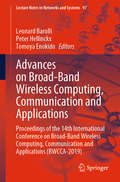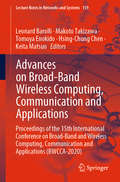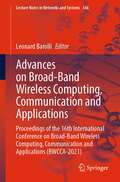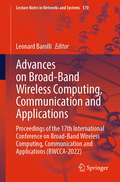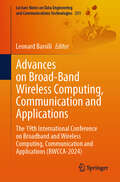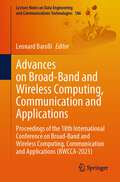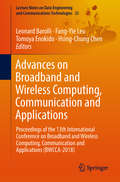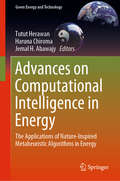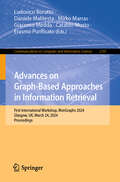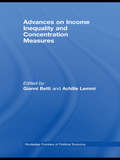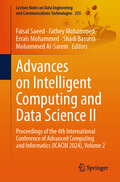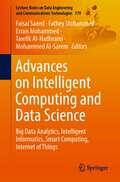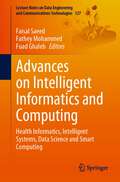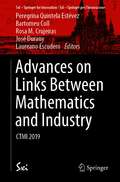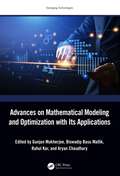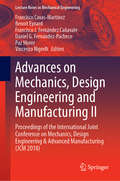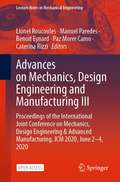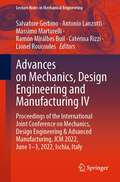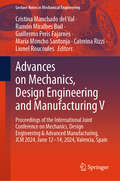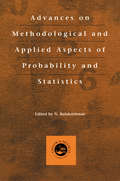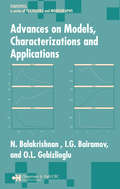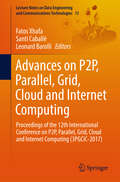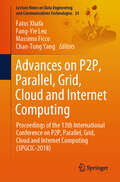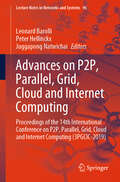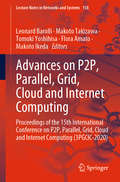- Table View
- List View
Advances on Broad-Band Wireless Computing, Communication and Applications: Proceedings of the 14th International Conference on Broad-Band Wireless Computing, Communication and Applications (BWCCA-2019) (Lecture Notes on Data Engineering and Communications Technologies #97)
by Leonard Barolli Tomoya Enokido Peter HellinckxThis proceedings book presents the latest research findings, innovative research results, methods and development techniques related to the emerging areas of broadband and wireless computing, from both theoretical and practical perspectives. Today’s information networks are going through a rapid evolution. Different kinds of networks with different characteristics are emerging, and are being integrated into heterogeneous networks. As a result, there are numerous interconnection problems that can occur at different levels of the hardware and software design of communicating entities and communication networks. Such networks need to manage an increasing usage demand, provide support for a significant number of services, guarantee their QoS, and optimize the network resources. The success of all-IP networking and wireless technology has changed the way of living for people around the globe. Advances in electronic integration and wireless communications will pave the way to offering access to wireless networks on the fly, which in turn will allow electronic devices to share information with each other wherever and whenever necessary.
Advances on Broad-Band Wireless Computing, Communication and Applications: Proceedings of the 15th International Conference on Broad-Band and Wireless Computing, Communication and Applications (BWCCA-2020) (Lecture Notes in Networks and Systems #159)
by Makoto Takizawa Leonard Barolli Tomoya Enokido Hsing-Chung Chen Keita MatsuoThis book aims to provide the latest research findings, innovative research results, methods and development techniques from both theoretical and practical perspectives related to the emerging areas of broadband and wireless computing. Information networks of today are going through a rapid evolution. Different kinds of networks with different characteristics are emerging, and they are integrating in heterogeneous networks. For these reasons, there are many interconnection problems which may occur at different levels of the hardware and software design of communicating entities and communication networks. These kinds of networks need to manage an increasing usage demand, provide support for a significant number of services, guarantee their QoS, and optimize the network resources. The success of all-IP networking and wireless technology has changed the ways of living the people around the world. The progress of electronic integration and wireless communications is going to pave the way to offer people the access to the wireless networks on the fly, based on which all electronic devices will be able to exchange the information with each other in ubiquitous way whenever necessary.
Advances on Broad-Band Wireless Computing, Communication and Applications: Proceedings of the 16th International Conference on Broad-Band Wireless Computing, Communication and Applications (BWCCA-2021) (Lecture Notes in Networks and Systems #346)
by Leonard BarolliThis book states that information networks of today are going through a rapid evolution. Different kinds of networks with different characteristics are emerging and they are integrating in heterogeneous networks. For these reasons, there are many interconnection problems which may occur at different levels of the hardware and software design of communicating entities and communication networks. These kinds of networks need to manage an increasing usage demand, provide support for a significant number of services, guarantee their QoS, and optimize the network resources. The success of all-IP networking and wireless technology has changed the ways of living the people around the world. The progress of electronic integration and wireless communications is going to pave the way to offer people the access to the wireless networks on the fly, based on which all electronic devices will be able to exchange the information with each other in ubiquitous way whenever necessary.The aim of the book is to provide latest research findings, innovative research results, methods, and development techniques from both theoretical and practical perspectives related to the emerging areas of broad-band and wireless computing.
Advances on Broad-Band Wireless Computing, Communication and Applications: Proceedings of the 17th International Conference on Broad-Band Wireless Computing, Communication and Applications (BWCCA-2022) (Lecture Notes in Networks and Systems #570)
by Leonard BarolliThis book aims to provide latest research findings, innovative research results, methods, and development techniques from both theoretical and practical perspectives related to the emerging areas of broadband and wireless computing. Information networks of today are going through a rapid evolution. Different kinds of networks with different characteristics are emerging, and they are integrating in heterogeneous networks. For these reasons, there are many interconnection problems which may occur at different levels of the hardware and software design of communicating entities and communication networks. These kinds of networks need to manage an increasing usage demand, provide support for a significant number of services, guarantee their QoS, and optimize the network resources. The success of all-IP networking and wireless technology has changed the ways of living the people around the world. The progress of electronic integration and wireless communications is going to pave the way to offer people the access to the wireless networks on the fly, based on which all electronic devices will be able to exchange the information with each other in ubiquitous way whenever necessary.
Advances on Broad-Band Wireless Computing, Communication and Applications: The 19th International Conference on Broadband and Wireless Computing, Communication and Applications (BWCCA-2024) (Lecture Notes on Data Engineering and Communications Technologies #231)
by Leonard BarolliThis book aims to provide latest research findings, innovative research results, methods, and development techniques from both theoretical and practical perspectives related to the emerging areas of broadband and wireless computing. Information networks of today are going through a rapid evolution. Different kinds of networks with different characteristics are emerging and they are integrating in heterogeneous networks. For these reasons, there are many interconnection problems which may occur at different levels of the hardware and software design of communicating entities and communication networks. These kinds of networks need to manage an increasing usage demand, provide support for a significant number of services, guarantee their QoS, and optimize the network resources. The success of all-IP networking and wireless technology has changed the ways of living the people around the world. The progress of electronic integration and wireless communications is going to pave the way to offer people the access to the wireless networks on the fly, based on which all electronic devices will be able to exchange the information with each other in ubiquitous way whenever necessary.
Advances on Broad-Band and Wireless Computing, Communication and Applications: Proceedings of the 18th International Conference on Broad-Band and Wireless Computing, Communication and Applications (BWCCA-2023) (Lecture Notes on Data Engineering and Communications Technologies #186)
by Leonard BarolliThe aim of this book is to provide latest research findings, innovative research results, methods, and development techniques from both theoretical and practical perspectives related to the emerging areas of broad-band and wireless computing. Information networks of today are going through a rapid evolution. Different kinds of networks with different characteristics are emerging and they are integrating in heterogeneous networks. For these reasons, there are many interconnection problems which may occur at different levels of the hardware and software design of communicating entities and communication networks. These kinds of networks need to manage an increasing usage demand, provide support for a significant number of services, guarantee their QoS, and optimize the network resources. The success of all-IP networking and wireless technology has changed the ways of living the people around the world. The progress of electronic integration and wireless communications is going to pave the way to offer people the access to the wireless networks on the fly, based on which all electronic devices will be able to exchange the information with each other in ubiquitous way whenever necessary.
Advances on Broadband and Wireless Computing, Communication and Applications: Proceedings of the 13th International Conference on Broadband and Wireless Computing, Communication and Applications (BWCCA-2018) (Lecture Notes on Data Engineering and Communications Technologies #25)
by Leonard Barolli Tomoya Enokido Fang-Yie Leu Hsing-Chung ChenThis book presents on the latest research findings, and innovative research methods and development techniques related to the emerging areas of broadband and wireless computing from both theoretical and practical perspectives.Information networking is evolving rapidly with various kinds of networks with different characteristics emerging and being integrated into heterogeneous networks. As a result, a number of interconnection problems can occur at different levels of the communicating entities and communication networks’ hardware and software design. These networks need to manage an increasing usage demand, provide support for a significant number of services, guarantee their QoS, and optimize the network resources. The success of all-IP networking and wireless technology has changed the way of life for people around the world, and the advances in electronic integration and wireless communications will pave the way for access to the wireless networks on the fly. This in turn means that all electronic devices will be able to exchange the information with each other in a ubiquitous way whenever necessary.
Advances on Computational Intelligence in Energy: The Applications of Nature-Inspired Metaheuristic Algorithms in Energy (Green Energy and Technology)
by Jemal H. Abawajy Tutut Herawan Haruna ChiromaAddressing the applications of computational intelligence algorithms in energy, this book presents a systematic procedure that illustrates the practical steps required for applying bio-inspired, meta-heuristic algorithms in energy, such as the prediction of oil consumption and other energy products. Contributions include research findings, projects, surveying work and industrial experiences that describe significant advances in the applications of computational intelligence algorithms in energy. For easy understanding, the text provides practical simulation results, convergence and learning curves as well as illustrations and tables. Providing a valuable resource for undergraduate and postgraduate students alike, it is also intended for researchers in the fields of computational intelligence and energy.
Advances on Graph-Based Approaches in Information Retrieval: First International Workshop, IRonGraphs 2024, Glasgow, UK, March 24, 2024, Proceedings (Communications in Computer and Information Science #2197)
by Ludovico Boratto Cataldo Musto Mirko Marras Daniele Malitesta Giacomo Medda Erasmo PurificatoThis book constitutes the refereed proceedings of the First International Workshop on Graph-Based Approaches in Information Retrieval, IRonGraphs 2024, held in Glasgow, UK, on March 24, 2024. The 6 full papers included in this book were carefully reviewed and selected from 14 submissions. They focus on diverse novel contributions, with presentations on knowledge-aware graph-based recommender systems using user-based semantic features filtering, source-target node distance impacts on adversarial attacks in social network recommendations.
Advances on Income Inequality and Concentration Measures (Routledge Frontiers Of Political Economy Ser.)
by Gianni Betti Achille LemmiThis impressive collection from some of today‘s leading distributional analysts provides an overview a wide range of economic, statistical and sociological relationships that have been opened up for scientific study by the work of two turn-of-the-20th-century economists: C. Gini and M. O. Lorenz. The authors include such figues as Barry A
Advances on Intelligent Computing and Data Science II: Proceedings of the 4th International Conference of Advanced Computing and Informatics (ICACIN 2024), Volume 2 (Lecture Notes on Data Engineering and Communications Technologies #255)
by Faisal Saeed Fathey Mohammed Errais Mohammed Mohammed Al-Sarem Shadi BasurraThis book presents the proceedings of the 4th International Conference on Advanced Computing and Informatics (ICACIn&’24). The conference, held on December 16–17, 2024, at STEAMhouse, Birmingham City University (UK), with a parallel session at Hassan II University (Morocco), attracted submissions by researchers in 20 countries. Out of 91 submissions, 46 high-quality papers were selected, presenting the latest advancements and cutting-edge developments in computing and informatics. The book covers a wide range of advanced computing topics, including data science, big data analytics, the Internet of Things (IoT), smart computing, artificial intelligence, machine learning, cybersecurity, intelligent communication systems, health informatics, and information systems. Designed for researchers, practitioners, and graduate students, this book serves as a valuable resource for exploring advanced intelligent computing techniques and their real-world applications.
Advances on Intelligent Computing and Data Science: Big Data Analytics, Intelligent Informatics, Smart Computing, Internet of Things (Lecture Notes on Data Engineering and Communications Technologies #179)
by Faisal Saeed Fathey Mohammed Tawfik Al-Hadhrami Errais Mohammed Mohammed Al-SaremThis book presents the papers included in the proceedings of the 3rd International Conference of Advanced Computing and Informatics (ICACin’22) that was held in Casablanca, Morocco, on October 15–16, 2022. A total of 98 papers were submitted to the conference, but only 60 papers were accepted and published in this book with an acceptance rate of 61%. The book presents several hot research topics which include artificial intelligence and data science, big data analytics, Internet of Things (IoT) and smart cities, information security, cloud computing and networking, and computational informatics.
Advances on Intelligent Informatics and Computing: Health Informatics, Intelligent Systems, Data Science and Smart Computing (Lecture Notes on Data Engineering and Communications Technologies #127)
by Faisal Saeed Fathey Mohammed Fuad GhalebThis book presents emerging trends in intelligent computing and informatics. This book presents the papers included in the proceedings of the 6th International Conference of Reliable Information and Communication Technology 2021 (IRICT 2021) that was held virtually, on Dec. 22-23, 2021. The main theme of the book is “Advances on Intelligent Informatics and Computing”. A total of 87 papers were submitted to the conference, but only 66 papers were accepted and published in this book. The book presents several hot research topics which include health informatics, artificial intelligence, soft computing, data science, big data analytics, Internet of Things (IoT), intelligent communication systems, cybersecurity, and information systems.
Advances on Links Between Mathematics and Industry: CTMI 2019 (SxI - Springer for Innovation / SxI - Springer per l'Innovazione #15)
by Peregrina Quintela Estévez Bartomeu Coll Rosa M. Crujeiras José Durany Laureano EscuderoThis book results from the talks presented at the First Conference on Transfer between Mathematics & Industry (CTMI 2019). Its goal is to promote and disseminate the mathematical tools for Statistics & Big Data, MSO (Modeling, Simulation and Optimization) and their industrial applications. In this volume, the reader will find innovative advances in the automotive, energy, railway, logistics, and materials sectors. In addition, Advances CTMI 2019 promotes the opening of new research lines aiming to provide suitable solutions for the industrial and societal challenges. Fostering effective interaction between Academia and Industry is our main purpose with this book. CTMI conferences are one of the main forums where significant advances in industrial mathematics are presented, bringing together outstanding leaders from business, science and Academia to promote the use of mathematics for an innovative industry.
Advances on Mathematical Modeling and Optimization with Its Applications (Emerging Technologies)
by Gunjan Mukherjee Aryan Chaudhary Biswadip Basu Mallik Rahul KarAdvances on Mathematical Modeling and Optimization with Its Applications discusses optimization, equality, and inequality constraints and their application in the versatile optimizing domain. It further covers non-linear optimization methods such as global optimization, and gradient-based non-linear optimization, and their applications. Discusses important topics including multi-component differential equations, geometric partial differential equations, and computational neural systems Covers linear integer programming and network design problems, along with an application of the mixed integer problems Discusses constrained and unconstrained optimization, equality, and inequality constraints, and their application in the versatile optimizing domain Elucidates the application of statistical models, probability models, and transfer learning concepts Showcases the importance of multi-attribute decision modeling in the domain of image processing and soft computing The text is primarily for senior undergraduate and graduate students, and academic researchers in the fields of mathematics, statistics, and computer science.
Advances on Mechanics, Design Engineering and Manufacturing II: Proceedings of the International Joint Conference on Mechanics, Design Engineering & Advanced Manufacturing (JCM 2018) (Lecture Notes in Mechanical Engineering)
by Benoit Eynard Vincenzo Nigrelli Francisco Cavas-Martínez Francisco J. Fernández Cañavate Daniel G. Fernández-Pacheco Paz MorerThis book contains the papers presented at the International Joint Conference on Mechanics, Design Engineering and Advanced Manufacturing (JCM 2018), held on 20-22 June 2018 in Cartagena, Spain. It reports on cutting-edge topics in product design and manufacturing, such as industrial methods for integrated product and process design; innovative design; and computer-aided design. Further topics covered include virtual simulation and reverse engineering; additive manufacturing; product manufacturing; engineering methods in medicine and education; representation techniques; and nautical, aeronautics and aerospace design and modeling. The book is divided into six main sections, reflecting the focus and primary themes of the conference. The contributions presented here will not only provide researchers, engineers and experts in a range of industrial engineering subfields with extensive information to support their daily work; they are also intended to stimulate new research directions, advanced applications of the methods discussed, and future interdisciplinary collaborations.
Advances on Mechanics, Design Engineering and Manufacturing III: Proceedings of the International Joint Conference on Mechanics, Design Engineering & Advanced Manufacturing, JCM 2020, June 2-4, 2020 (Lecture Notes in Mechanical Engineering)
by Caterina Rizzi Benoit Eynard Manuel Paredes Paz Morer Camo Lionel RoucoulesThis open access book gathers contributions presented at the International Joint Conference on Mechanics, Design Engineering and Advanced Manufacturing (JCM 2020), held as a web conference on June 2–4, 2020. It reports on cutting-edge topics in product design and manufacturing, such as industrial methods for integrated product and process design; innovative design; and computer-aided design. Further topics covered include virtual simulation and reverse engineering; additive manufacturing; product manufacturing; engineering methods in medicine and education; representation techniques; and nautical, aeronautics and aerospace design and modeling. The book is organized into four main parts, reflecting the focus and primary themes of the conference. The contributions presented here not only provide researchers, engineers and experts in a range of industrial engineering subfields with extensive information to support their daily work; they are also intended to stimulate new research directions, advanced applications of the methods discussed and future interdisciplinary collaborations.
Advances on Mechanics, Design Engineering and Manufacturing IV: Proceedings of the International Joint Conference on Mechanics, Design Engineering & Advanced Manufacturing, JCM 2022, June 1-3, 2022, Ischia, Italy (Lecture Notes in Mechanical Engineering)
by Caterina Rizzi Lionel Roucoules Salvatore Gerbino Antonio Lanzotti Massimo Martorelli Ramón Mirálbes BuilThis book gathers contributions presented at the International Joint Conference on Mechanics, Design Engineering and Advanced Manufacturing (JCM 2022), held on June 1–3, 2022, in Ischia, Italy. It reports on cutting-edge topics in product design and manufacturing, such as industrial methods for integrated product and process design; innovative design; and computer-aided design. Further topics covered include virtual simulation and reverse engineering; additive manufacturing; product manufacturing; engineering methods in medicine and education; representation techniques; and collaborative and soft robotics. The book is organized into five main parts, reflecting the focus and primary themes of the conference. The contributions presented here not only provide researchers, engineers and experts in a range of industrial engineering subfields with extensive information to support their daily work; they are also intended to stimulate new research directions, advanced applications of the methods discussed and future interdisciplinary collaborations.
Advances on Mechanics, Design Engineering and Manufacturing V: Proceedings of the International Joint Conference on Mechanics, Design Engineering & Advanced Manufacturing, JCM 2024, June 12–14, 2024, Valencia, Spain (Lecture Notes in Mechanical Engineering)
by Caterina Rizzi Lionel Roucoules Cristina Manchado del Val Ramón Miralbes Buil Guillermo Peris Fajarnés María Moncho SantonjaThis book contains the papers presented at the International Joint Conference on Mechanics, Design Engineering & Advanced Manufacturing, JCM 2024, held on 12-14 June in Valencia, Spain. It reports on cutting-edge topics in product design and manufacturing, such as industrial methods for integrated product and process design; innovative design; and computer-aided design. Further topics covered include virtual simulation and reverse engineering; additive manufacturing; product manufacturing; engineering methods in medicine and education; representation techniques; and nautical, engineering and construction, aeronautics and aerospace design and modeling. The book is divided into six main sections, reflecting the focus and primary themes of the conference. The contributions presented in this book will not only provide researchers, engineers and experts in a range of industrial engineering subfields with extensive information to support their daily work; but also stimulate new research directions, advanced applications of the methods discussed, and future interdisciplinary collaborations.
Advances on Methodological and Applied Aspects of Probability and Statistics
by N. BalakrishnanThis is one of two volumes that sets forth invited papers presented at the International Indian Statistical Association Conference. This volume emphasizes advancements in methodology and applications of probability and statistics. The chapters, representing the ideas of vanguard researchers on the topic, present several different subspecialties, including applied probability, models and applications, estimation and testing, robust inference, regression and design and sample size methodology. The text also fully describes the applications of these new ideas to industry, ecology, biology, health, economics and management. Researchers and graduate students in mathematical analysis, as well as probability and statistics professionals in industry, will learn much from this volume.
Advances on Models, Characterizations and Applications
by N. Balakrishnan I. G. Bairamov O. L. GebizliogluStatistical distributions are one of the most important applied mathematical tools across a wide spectrum of disciplines, including engineering, biological sciences, and health and social sciences. Since they are used to model observed data and ultimately to develop inferential procedures, understanding the properties of statistical distributions i
Advances on P2P, Parallel, Grid, Cloud and Internet Computing: Proceedings of the 12th International Conference on P2P, Parallel, Grid, Cloud and Internet Computing (3PGCIC-2017) (Lecture Notes on Data Engineering and Communications Technologies #13)
by Fatos Xhafa Leonard Barolli Santi CaballéP2P, Grid, Cloud and Internet computing technologies have been very fast established as breakthrough paradigms for solving complex problems by enabling aggregation and sharing of an increasing variety of distributed computational resources at large scale. The aim of this volume is to provide latest research findings, innovative research results, methods and development techniques from both theoretical and practical perspectives related to P2P, Grid, Cloud and Internet computing as well as to reveal synergies among such large scale computing paradigms. This proceedings volume presents the results of the 11th International Conference on P2P, Parallel, Grid, Cloud And Internet Computing (3PGCIC-2016), held November 5-7, 2016, at Soonchunhyang University, Asan, Korea
Advances on P2P, Parallel, Grid, Cloud and Internet Computing: Proceedings of the 13th International Conference on P2P, Parallel, Grid, Cloud and Internet Computing (3PGCIC-2018) (Lecture Notes on Data Engineering and Communications Technologies #24)
by Fatos Xhafa Fang-Yie Leu Massimo Ficco Chao-Tung YangThis book presents the latest research findings, as well as innovative theoretical and practical research results, methods and development techniques related to P2P, grid, cloud and Internet computing. It also reveals the synergies among such large scale computing paradigms. P2P, Grid, Cloud and Internet computing technologies have rapidly become established as breakthrough paradigms for solving complex problems by enabling aggregation and sharing of an increasing variety of distributed computational resources on a large scale. Grid computing originated as a paradigm for high-performance computing, offering an alternative to expensive supercomputers through different forms of large-scale distributed computing. P2P computing emerged as a new paradigm following on from client-server and web-based computing and has proved useful in the development of social networking, B2B (Business to Business), B2C (Business to Consumer), B2G (Business to Government), and B2E (Business to Employee). Cloud computing has been described as a “computing paradigm where the boundaries of computing are determined by economic rationale rather than technical limits”. Cloud computing has fast become the computing paradigm with applicability and adoption in all domains and providing utility computing at large scale. Lastly, Internet computing is the basis of any large-scale distributed computing paradigm; it has very quickly developed into a vast and flourishing field with enormous impact on today’s information societies and serving as a universal platform comprising a large variety of computing forms such as grid, P2P, cloud and mobile computing.
Advances on P2P, Parallel, Grid, Cloud and Internet Computing: Proceedings of the 14th International Conference on P2P, Parallel, Grid, Cloud and Internet Computing (3PGCIC-2019) (Lecture Notes in Networks and Systems #96)
by Leonard Barolli Juggapong Natwichai Peter HellinckxThis book presents the latest research findings, innovative research results, methods and development techniques related to P2P, grid, cloud and Internet computing from both theoretical and practical perspectives. It also reveals the synergies among such large-scale computing paradigms. P2P, grid, cloud and Internet computing technologies have rapidly become established as breakthrough paradigms for solving complex problems by enabling aggregation and sharing of an increasing variety of distributed computational resources at large scale.Grid computing originated as a paradigm for high-performance computing, as an alternative to expensive supercomputers through different forms of large-scale distributed computing. P2P computing emerged as a new paradigm after client–server and web-based computing and has proved useful in the development of social networking, B2B (business to business), B2C (business to consumer), B2G (business to government), and B2E (business to employee). Cloud computing has been defined as a “computing paradigm where the boundaries of computing are determined by economic rationale rather than technical limits,” and it has fast become a computing paradigm with applicability and adoption in all application domains and which provides utility computing at a large scale. Lastly, Internet computing is the basis of any large-scale distributed computing paradigms; it has developed into a vast area of flourishing fields with enormous impact on today’s information societies, and serving as a universal platform comprising a large variety of computing forms such as grid, P2P, cloud and mobile computing.
Advances on P2P, Parallel, Grid, Cloud and Internet Computing: Proceedings of the 15th International Conference on P2P, Parallel, Grid, Cloud and Internet Computing (3PGCIC-2020) (Lecture Notes in Networks and Systems #158)
by Makoto Takizawa Leonard Barolli Makoto Ikeda Flora Amato Tomoki YoshihisaThis book aims to provide the latest research findings, innovative research results, methods and development techniques from both theoretical and practical perspectives related to P2P, Grid, Cloud and Internet computing as well as to reveal synergies among such large-scale computing paradigms. P2P, Grid, Cloud and Internet computing technologies have been very fast established as breakthrough paradigms for solving complex problems by enabling aggregation and sharing of an increasing variety of distributed computational resources at large scale. Grid Computing originated as a paradigm for high-performance computing, as an alternative to expensive supercomputers through different forms of large-scale distributed computing. P2P Computing emerged as a new paradigm after client–server and web-based computing and has shown useful to the development of social networking, B2B (Business to Business), B2C (Business to Consumer), B2G (Business to Government), B2E (Business to Employee), and so on. Cloud Computing has been defined as a “computing paradigm where the boundaries of computing are determined by economic rationale rather than technical limits”. Cloud computing has fast become the computing paradigm with applicability and adoption in all application domains and providing utility computing at large scale. Finally, Internet Computing is the basis of any large-scale distributed computing paradigms; it has very fast developed into a vast area of flourishing field with enormous impact on today’s information societies serving thus as a universal platform comprising a large variety of computing forms such as Grid, P2P, Cloud and Mobile computing.
